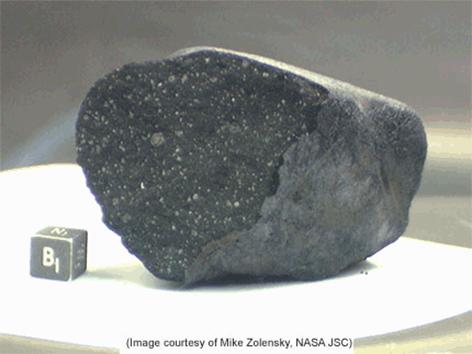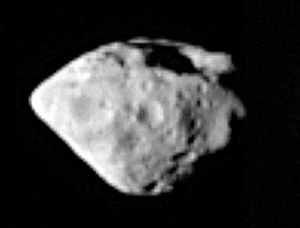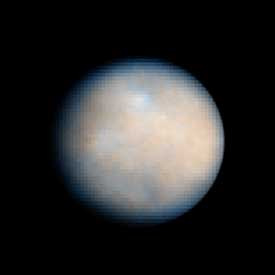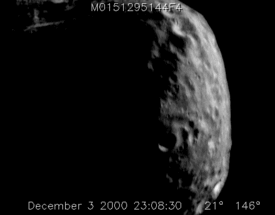asteroid spectral types

Figure 1. A fragment of the Tagish Lake meteorite, which fell in Canada in 2000, and is believed to have come from a D-class asteroid.

Figure 2. 2867 Steins.

Figure 3. Ceres: a G-class asteroid. Image credit: NASA/Hubble.

Figure 4. Animation of the rotation of 433 Eros.
One of the most important ways to classify asteroids is by features in their reflectance spectra along with their color and albedo. These characteristics are related to the surface composition. A number of different classification schemes have been developed but the one seen most commonly is that proposed by David Tholen in 1984, and based on data fro the Eight-Color Asteroid Survey (ECAS) and albedo measurement. Fourteen different classes are recognized in the Tholen scheme.
A-type asteroid
A rare type of asteroid, reddish in color, with a moderately high albedo of 0.13 to 0.35. The infrared spectra of A-class asteroids suggest that these objects are rich in the mineral olivine. Examples include the asteroids 246 Asporina (diameter 70 kilometers), 446 Aeternotas (diameter 52 kilometers), and 5261 Eureka, the first Mars trojan to be discovered.
B-type asteroid
A subcategory of C-type asteroids whose members have albedos in the range 0.04 to 0.08. Although fairly low, this is at the high end for C-type objects. Examples include 2 Pallas (the second largest asteroid), 379 Huenna (diameter 62 kilometers), and 431 Nephele (diameter 78 kilometers).
C-type asteroid
A very dark and non-reflective type of asteroid, gray in color, with a composition believed to be similar to that of carbonaceous chondrites (the "C" stands for carbonaceous). C-type asteroids are the commonest type known and dominate the outer part of the main asteroid belt. They have an albedo of 0.03 to 0.09 and a reflectance spectrum that is flat at wavelengths longer than 0.4 micron but shows a feature shorter than 0.4 micron thought to be due to water of crystallization. Examples include 10 Hygiea and 253 Mathilde. Sub-types include B-type, F-type, and G-type asteroids.
D-type asteroid
A very dark and non-reflective asteroid, reddish in color, probably due to the surface presence of organic materials. Rare in the main belt, D-type asteroids crop up with increasing regularity beyond about 3.3 AU from the Sun. They have albedos of 0.02 to 0.05 and appear to be made of some of the most primitive material in the solar system (Figure 1).
Examples are found among many of Jupiter's trojans, including the largest, Hektor. Also the Martian moons Phobos and Deimos may well be captured D-type asteroids and the Tagish Lake meteorite has been confirmed as a probable D-type fragment, the most likely parent-body candidate being 773 Irmintraud.
E-type asteroid
A rare category of asteroid, slightly red in color and spectrally similar to M-type asteroids and P-type asteroids, but of higher albedo (in the range 0.25–0.60). E-type asteroids dominate the Hungaria group of the main belt, though some, including the two largest, 44 Nysa (see Nysa-Polana family and 64 Angelina, are found scattered further out. Their flat reflectance spectra in the 0.3 to 1.0 micron region and high albedos suggest a connection with the aubrite (otherwise known as enstatite achondrite, hence the "E") category of meteorite. However, this link is problematic because aubrites are clearly of igneous origin, whereas some E-class asteroids (including Nysa) show an absorption feature at 3 microns that points to water- and/or hydroxyl-bearing minerals and a non-igneous history.
The Rosetta spacecraft achieved the first fly-by of an E-type asteroid when it passed within 800 km of the main belt asteroid 2867 Steins on 5 September 2008. Steins has dimensions of 6.67 × 5.81 × 4.47 kilometers and a mean distance from the Sun of about 2.4 AU.
F-type asteroid
A dark asteroid belonging to a subcategory of C-type asteroids distinguished by having a weak to absent ultraviolet absorption feature. F-class asteroids account for most of the Polana faction of the Nysa-Polana family. They have albedos of 0.03 to 0.07 and featureless reflectance spectra across the range 0.3 to 1.1 microns.
G-type asteroid
A dark asteroid belonging to a subcategory of C-type asteroids, distinguished by having a very strong ultraviolet absorption feature at wavelengths shorter than 0.4 microns due to water of hydration in the surface rocks. G-class asteroids, of which the best known and largest example is Ceres (now officially classified as a dwarf planet) (Figure 3), have albedos of 0.05 to 0.09.
M-type asteroid
A relatively bright and reflective asteroid, made mainly of metallic iron and nickel (the "M" is for "metal"), typically found in the middle of the main asteroid belt. M-type asteroids are slightly reddish and have featureless reflectance spectra over the range 0.3 to 1.1 microns. They are distinguished from the spectrally similar E-type asteroids and P-type asteroids by their moderate albedo of 0.10 to 0.18. The largest known example is the 248-kilometer-wide 16 Psyche.
P-type asteroid
A dark type of asteroid, commonest in the outer part of the main asteroid belt at a solar distance of about 4 AU, with a spectrum intermediate between that of C-type asteroids and D-type asteroids. P-type objects are distinguished from the spectrally similar E-type and M-type asteroids by their lower albedo (in the range 0.02 to 0.06). The largest example is the 282-kilometer-wide 87 Sylvia.
Q-type asteroid
A rare class of asteroid of which only Apollo and a few other near-Earth asteroids are known to belong. Q types are fairly bright and have reflectance spectra with a strong absorption feature at wavelengths less than 0.7 micron and a mild one near 1 micron – spectra that are similar to those of ordinary carbonaceous chondrites.
R-type asteroid
An extremely red asteroid with a fairly
high albedo and strong absorption features
shorter than 0.7 micron and near 1 micron. Spectroscopic studies point to
a surface rich in basaltic minerals, including pyroxene and olivine. The only recognized example
is the main-belt asteroid 349 Dembowska.
However, the possibility has been raised that the near-Earth
asteroid 2001 XR31 may also be of class R.1
1. Marchi, S., Lazzarin, M., and Magrin S. "An R-type asteroid within
near-Earth objects?" Astronomy & Astrophysics, 420, L5-L8 (2004).
S-type asteroid
A moderately bright, slightly reddish type of asteroid believed to be composed largely of silicate minerals (the "S" stands for "siliceous") such as olivine and pyroxene. S-class asteroids are quite common in the inner part of the main asteroid belt, their proportion decreasing at greater distances from the Sun. They have an albedo of 0.10 to 0.28 and a reflectance spectrum that is flat at wavelengths longer than 0.7 micron. Examples include 433 Eros (Figure 4), 951 Gaspra, 15 Eunomia (see Eunomia family), and the 219-kilometer-diameter 29 Amphitrite. S-class asteroids may be the parent objects of stony-iron meteorites.
T-type asteroid
A rare type of asteroid with a fairly low albedo (0.04 to 011) and a moderate absorption feature at wavelengths shorter than 0.85 micron. Examples include 114 Kassandra and 233 Asterope.
V-type asteroid
A rare class of asteroid, of which Vesta is the preeminent member, characterized by fairly high albedo and a reflectance spectrum with strong absorption at wavelengths shorter than 0.7 micron and a separate dip near 0.95 micron. The latter suggests the presence of the silicate mineral pyroxene.


